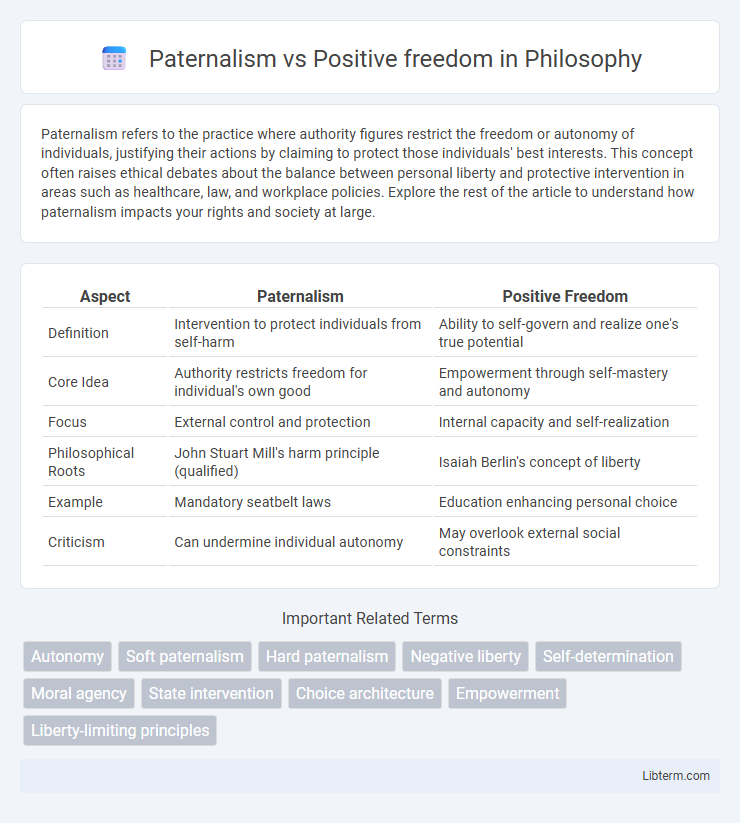Paternalism refers to the practice where authority figures restrict the freedom or autonomy of individuals, justifying their actions by claiming to protect those individuals' best interests. This concept often raises ethical debates about the balance between personal liberty and protective intervention in areas such as healthcare, law, and workplace policies. Explore the rest of the article to understand how paternalism impacts your rights and society at large.
Table of Comparison
| Aspect | Paternalism | Positive Freedom |
|---|---|---|
| Definition | Intervention to protect individuals from self-harm | Ability to self-govern and realize one's true potential |
| Core Idea | Authority restricts freedom for individual's own good | Empowerment through self-mastery and autonomy |
| Focus | External control and protection | Internal capacity and self-realization |
| Philosophical Roots | John Stuart Mill's harm principle (qualified) | Isaiah Berlin's concept of liberty |
| Example | Mandatory seatbelt laws | Education enhancing personal choice |
| Criticism | Can undermine individual autonomy | May overlook external social constraints |
Understanding Paternalism: Definitions and Origins
Paternalism refers to the practice of limiting an individual's liberty or autonomy for their own good, often justified by the belief that the authority knows better than the individual. Rooted in classical political philosophy, paternalism traces back to ancient thinkers like Plato and continues through modern debates on the balance between state intervention and personal freedom. Understanding its origins illuminates how the concept contrasts with positive freedom, which emphasizes self-mastery and the capacity to act according to one's true interests.
Positive Freedom: Concept and Philosophical Roots
Positive freedom centers on the capacity of individuals to realize their true potential and exercise self-mastery, transcending mere absence of constraints. Rooted in the philosophy of thinkers like Isaiah Berlin and Charles Taylor, it emphasizes empowerment through enabling conditions such as education, social justice, and participatory institutions. This concept challenges paternalism by advocating for structures that foster autonomy and genuine choice rather than imposing external control.
Historical Contexts: Paternalism in Policy and Society
Paternalism in policy and society has historically manifested through laws and regulations designed to protect individuals from harm, often limiting personal autonomy for perceived collective benefits. Prominent examples include temperance movements and public health mandates in the 19th and 20th centuries, reflecting a belief that authorities possess superior knowledge to guide citizens' choices. These policies illustrate a tension between control and freedom, contrasting with positive freedom's emphasis on enabling individuals to realize their own potential through self-mastery and empowerment.
Positive Freedom in Modern Democracies
Positive freedom in modern democracies emphasizes individuals' capacity to act upon their own free will by providing opportunities such as education, healthcare, and social security. This approach supports enabling citizens to fulfill their potential and participate meaningfully in political and social life without external constraints or coercion. By prioritizing positive freedom, democratic governments aim to balance individual autonomy with collective welfare, fostering inclusive societies where equal access to resources empowers personal and civic development.
Key Philosophers: Mill, Berlin, and Beyond
John Stuart Mill argued against paternalism, emphasizing individual liberty and the harm principle as essential to positive freedom. Isaiah Berlin distinguished between negative freedom, or freedom from interference, and positive freedom, the capacity to act on one's own will, warning against paternalistic overreach that undermines autonomy. Contemporary debates extend these foundations by examining the balance between state intervention for welfare and respecting individual self-determination.
Conflicts Between Paternalism and Autonomy
Conflicts between paternalism and autonomy arise when interventions intended to protect individuals from harm infringe upon their capacity to make independent choices. Paternalism often restricts personal freedom to promote well-being, whereas positive freedom emphasizes the individual's ability to act according to their true interests and values. Balancing these concepts requires careful consideration of when limiting autonomy is justified without undermining self-determination.
Practical Examples: Public Health and Social Policy
Public health policies mandating vaccinations exemplify paternalism by restricting individual choice to protect communal health, while positive freedom emphasizes empowering individuals through education and access to healthcare resources. Social policies like smoking bans illustrate paternalism by limiting behaviors deemed harmful, whereas initiatives promoting wellness programs support positive freedom by fostering environments where individuals can make healthier choices. Balancing these approaches requires evaluating the extent of state intervention necessary to safeguard public welfare without undermining personal autonomy.
Ethical Dilemmas: Balancing Protection and Liberty
Ethical dilemmas in paternalism versus positive freedom center on protecting individuals from harm while respecting their autonomy to make free choices. Paternalism involves intervention to prevent self-harm, often justified by moral responsibility, but risks infringing on personal liberty and agency. Positive freedom emphasizes empowering individuals to pursue self-realization, challenging restrictions that paternalistic approaches may impose in the name of protection.
Criticisms of Paternalism and Positive Freedom
Criticisms of paternalism often highlight its tendency to undermine individual autonomy by imposing decisions on individuals "for their own good," which can lead to authoritarianism and the erosion of personal freedoms. Conversely, critiques of positive freedom emphasize the risk of state overreach in defining what constitutes true self-realization, potentially justifying coercive measures that limit choice under the guise of empowerment. Both concepts spark debate over balancing individual rights with societal goals, raising essential questions about liberty, control, and the role of government.
Shaping the Future: Finding a Middle Ground
Paternalism involves restricting individual freedoms for their own good, while positive freedom emphasizes enabling individuals to realize their true potential through support and empowerment. Shaping the future requires balancing these concepts by creating policies that protect people without unduly limiting their autonomy, fostering environments where individuals can make informed choices. This middle ground ensures societal progress by promoting both security and personal growth, aligning governance with human dignity and capability development.
Paternalism Infographic

 libterm.com
libterm.com